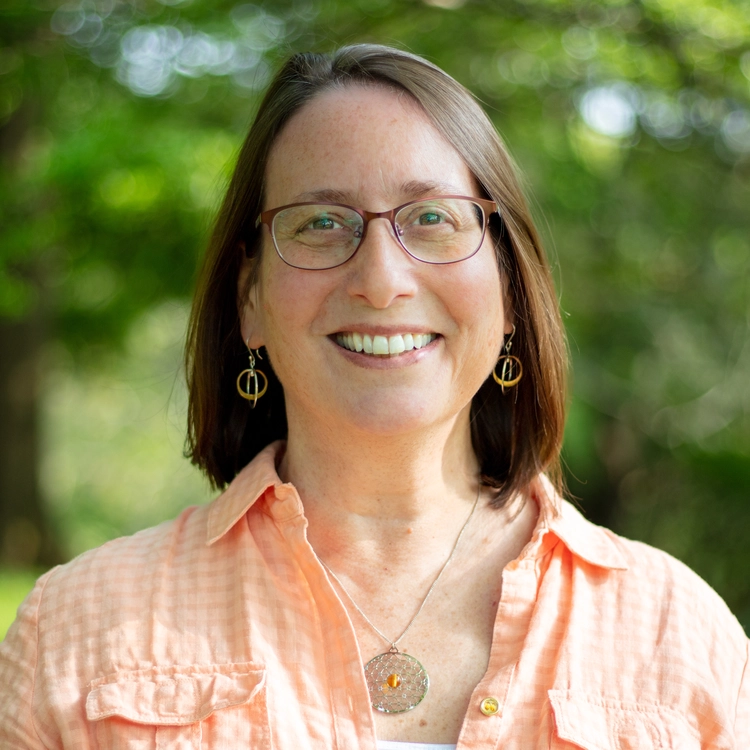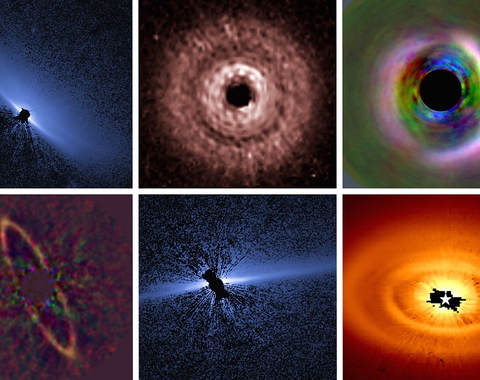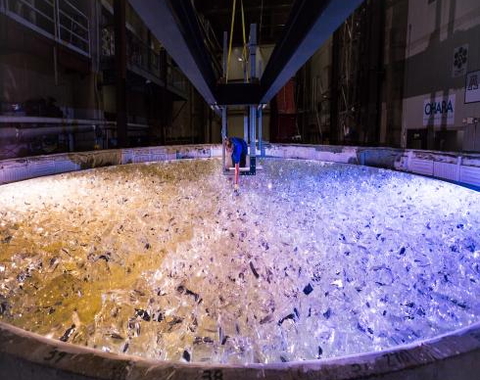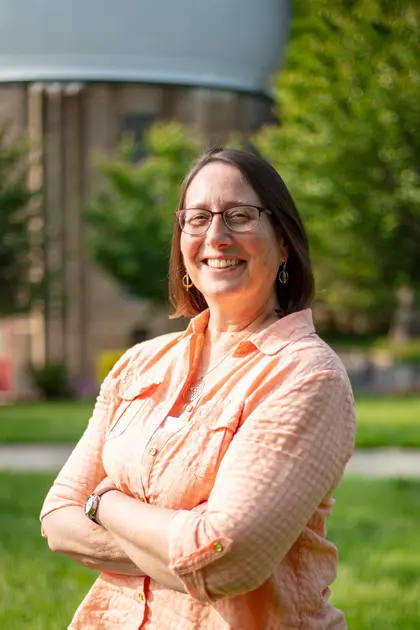
From her very first telescope in 8th grade, Alycia Weinberger has loved astronomy.
As a Staff Scientist at the Earth and Planets Laboratory (EPL) since 2001, Alycia Weinberger has spent decades researching protoplanetary disks, the early history of planets, and the conditions necessary for their formation. But outside of astronomy, there has been another constant—a focus on people.
From labmates to lunch club, Weinberger aims to build the kind of positive research communities that helped cultivate her early passion for science and astronomy.
Now, in a new role as Associate Division Director, she’s doing just that. She works alongside Director Michael Walter to shape the cultural and scientific landscape at the Earth and Planets Laboratory—all while continuing her research.
Join us below for a friendly chat with Alycia as she shares her journey to astronomy, her dreams for this new role, her excitement about new technical strides in astronomy, and even her hopeful outlook on discovering life beyond our skies.
The following interview has been edited for clarity and length.
Highlights
- Early Journey: Discover Alycia Weinberger's transition from nuclear physics to observational astronomy, propeled by her love for telescopes and a vibrant research culture encountered during her undergraduate years.
- New Role: Weinberger's role as Associate Division Director at the Earth and Planets Laboratory focuses on shaping a positive and productive scientific environment, driven by her passion for improving research cultures.
- MagNIFIES Instrument: Learn about Weinberger's groundbreaking project, MagNIFIES, designed to revolutionize astronomical observation by enabling high-resolution studies of planet-forming regions and planetary atmospheres.
- Carnegie Advantage: Explore the unique advantages offered by Carnegie Science, including access to telescopes and a culture that fosters innovation and independence in scientific exploration.
- Future of Astronomy: Discover anticipated advancements in astronomy, challenges in securing funding for large-scale projects, and the excitement surrounding the possibility of discovering extraterrestrial life.
- Connecting with Weinberger: Weinberger welcomes open communication at the Earth and Planets Laboratory, encouraging discussions on science, improvements for Carnegie, or engaging conversations about astronomy.
Early Journey to Astronomy
What inspired you to pursue a career in astronomy?
I have always been interested in astronomy, and I have always loved using telescopes—the bigger, the better! I also like hardware and working with my hands. So, observational astronomy has fulfilled all of those things that I love. I’ve also always been more of a night person, which certainly helps!
Have you always studied astronomy?
No! You know, I was actually just reflecting on how I wound up in astronomy.
This year, I gave a talk at Indiana University, which is where I did a summer internship after my sophomore year of college. While I was there, I got to have breakfast with the mentor that I had that summer. Back then, I was working on a project in nuclear physics.
Even though I didn’t end up going into nuclear physics, there were aspects of that field that I really liked that I continue to pursue as an astronomer. For example, I got to work with a cyclotron, this massive piece of hardware. And just like the telescopes I work with today, the bigger the better!
There was also a feeling of camaraderie in the group that worked at the cyclotron. They were a team of people with a common set of scientific interests who championed each other's work. They were just as excited about doing science as I was. All in all, it was a very good research environment.
I was lucky to have experienced that as an undergraduate. It's the kind of research environment I’ve had in mind ever since.
How did you get from nuclear physics to observational astronomy?
For graduate school, I intended to extend what I had done with particle physics and nuclear physics. My original plan was to combine the two and study particle astrophysics at Caltech, but I was also interested in astronomy. I’d had my own little telescope since I bought it using an 8th-grade science prize, plus a generous donation from my parents.
But, through happenstance, when I showed up, the particle astrophysics group was in the process of disassembling itself. So, I started searching around for other opportunities, and the observational astronomers who had a physics-y approach to astronomy seemed like a natural fit.
I pivoted. I made the choice almost more on the basis of what opportunities existed and who the people were rather than the research subject itself. It worked out for me!
How important was your postdoctoral experience to your career?
My postdoc years were quite a transformational experience. I made another scientific pivot. I started studying circumstellar disks—my main scientific interest now—when I was a postdoc at UCLA. I also found the research environment welcoming and inclusive, particularly for women.
I always recommend that people do a postdoc if they can. It was so important for me, and I hope that my experience translates for them.
How is being a postdoc different from when you’re a Ph.D. student?
You show up, and everyone assumes you know what you're doing! When you show up in graduate school, you don't really know anything.
As a postdoc, you've already become an expert in something, and you're ready to launch new projects. It’s always fun to get to start something new. But now, for the first time, you get to really hit the ground running.
It's also a great feeling to be a colleague and not a student. Your new department wanted you as a postdoc because they think you can do interesting things and want to have you around.
Plus, you get to build your professional network. I got to work with fabulous people when I was a postdoc who have remained really close collaborators to this day. I met lots of senior astronomers who came through to give seminars.
For me, it was a great experience, and I hope to provide similar outcomes for all the postdocs who come to EPL.
Stepping into a New Role
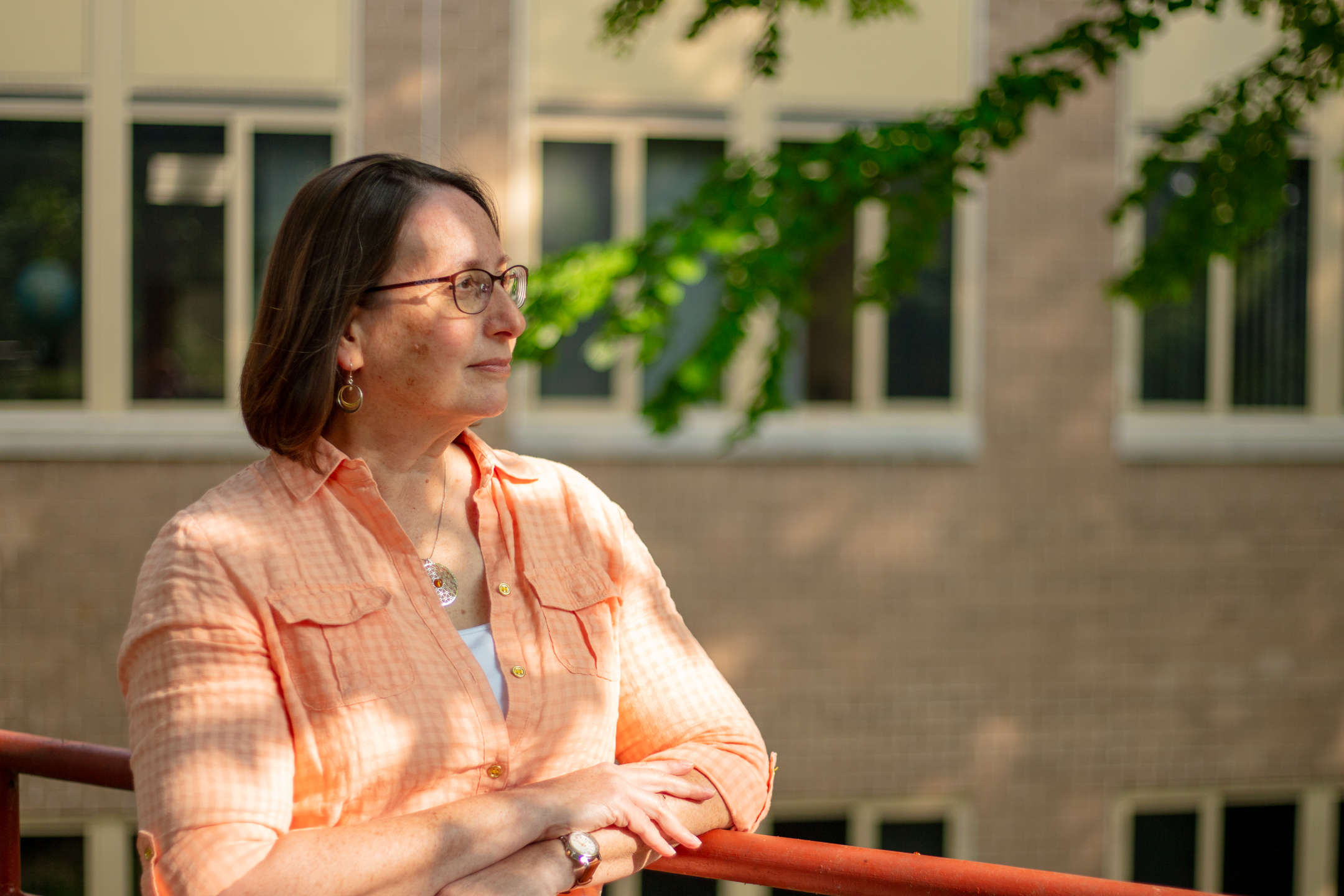
So what does the Associate Division Director do?
The Associate Division Director helps the Division Director, Mike Walter, with inward-facing tasks that enhance the experience on campus and improve and protect scientific productivity.
This involves a wide range of things, from running the postdoc selection process to improving the postdoc experience to building strategies for how we talk about our science to other scientists, the general public, and our supporters.
I’ll also have a bit of oversight on programs we do on campus regularly, like our seminar series and our summer internship program. Most of those are managed by other people, but I’ll ensure that there’s a manager and that they run smoothly.
This is the first time the Earth and Planets Laboratory has had this position. Why do you think the role is important?
The Earth and Planets Laboratory has only been around for a couple of years. In 2020, we combined two reasonably sized departments of about fourteen staff scientists, fourteen postdocs, and many technical and support staff into one department twice that size, which is actually quite large. But EPL still only has one Director, and it’s too big a job for just one person who also wants to be active in their research.
All of that happened during the pandemic, so there was a lot of change all at once. Now, we have an opportunity to be intentional about how to build EPL’s culture from the ground up.
This role plays a big part in that goal.
What inspired you to take on this new position?
I think I am constitutionally incapable of seeing problems and not fixing them—or attempting to fix them. This sometimes means that I get frustrated and spin my wheels because it’s not a problem that I have the power to solve. As a result, I was already talking with a lot of people and making connections within Carnegie. I was trying to solve problems that I found personally irritating or that I thought could be fixed to make scientific life at Carnegie a little better. For example, I wanted a better jobs system that would make hiring go more smoothly.
One day, a colleague said to me: “Why are you doing all these things when it’s not your job?”
That was a good question! It’s because I wanted to make this place work better for me and for everyone here.
When this opportunity came up to have some of these cultural and workflow pieces be part of my job, it made perfect sense to take it on as a formal role. I was already doing a lot of it!
How does it feel to have some of these extra duties pulled together into a formal role?
These types of roles don’t happen often—especially for people like me who try to fix things and often end up taking on a bunch of extra work in the process.
I don’t think I really have any more authority than I did before, but it does feel good to have this work codified as a part of my job rather than feeling like it’s getting in the way of the things I’m supposed to be doing.
What ultimately drives you in this role?
I’m a huge Carnegie booster. I really like this place. I have wanted to spend my whole career here, and I’m not particularly interested in leaving.
I want it to work and to work well. To me, that means sustaining the flexible institution that was the reason I came here in the first place.
That’s almost in our charter, right? The Carnegie Science mission is “to encourage, in the broadest and most liberal manner, investigation, research, and discovery and the application of knowledge to the improvement of [hu]mankind...”
According to my colleagues at universities, we already have much less bureaucracy than our counterparts. I think it’s important that, to the extent possible, we should aim to maximize our scientific happiness. Encourage creativity and collaboration. Reduce red tape.
Our scientific flexibility and agility make Carnegie special. Let’s keep it that way!
What is the most important part of the job to you?
One of the biggest roles is managing the postdoctoral experience.
You know, I’ve always been interested in cultural issues about how we do science in addition to the science that we do. I’ve certainly been in research situations that have made me happier than others—with Carnegie Science being the happiest.
So, of course, I want that for everyone who comes through these doors. To be in a happy research environment where one can do one’s best work and be productive.
How do you plan to ensure the postdoctoral experience continues to be a positive experience?
I think we have all the essential ingredients. We have amazing laboratories. We have really smart scientists. We have really smart postdocs. We have great people and support staff. We have really nice events on campus. We have really nice spaces for people to give a practice talk or have a private meeting—people just need to know how to take advantage of it.
I hope to get people talking to each other more and to make sure our postdocs get excellent mentoring. So far, I’ve revamped our postdoc orientation, written guides for new postdocs, surveyed our postdocs to find out about their experiences, and am rolling out an annual self-assessment process to help postdocs achieve as much as possible during their time at EPL.
I’ve also started an ethics discussion group because I think we need to consider the nuances of working in science, such as how we determine authorship, how we acknowledge prior work, and how we sustain our fields to be places we want to work in.
What’s one message you would send to our current postdocs?
Go to seminars! Talk to people!
MagNIFIES and Instrumentation
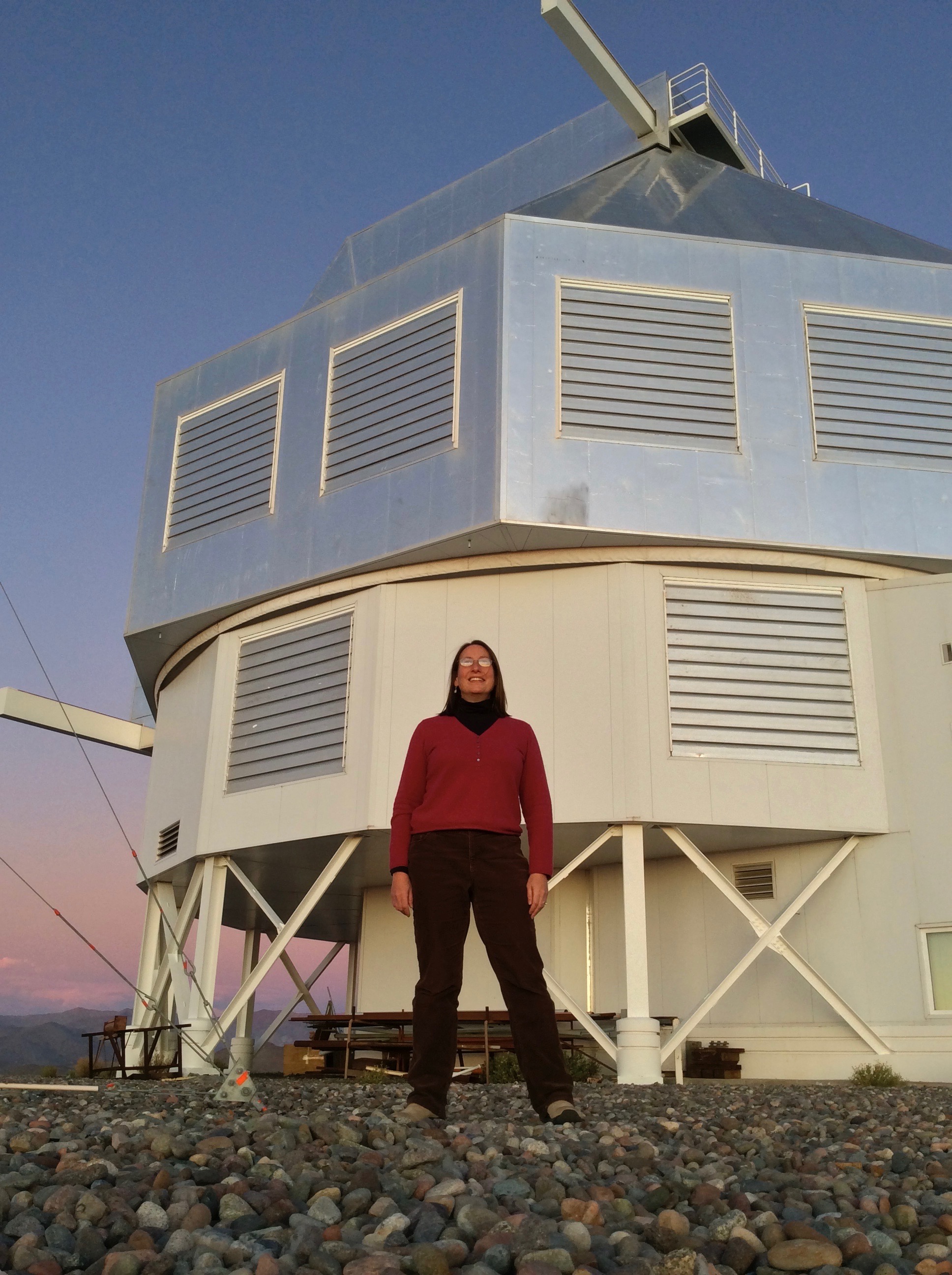
Switching gears for a minute to talk about science. In addition to this new role, you’re still an astronomer at Carnegie Science and extremely active in your scientific projects. One example is an instrument called MagNIFIES (Magellans' Near-Infrared Five-band Immersion Grating Efficient Spectrograph).
What is MagNIFIES, and what does it do?
MagNIFIES was designed by Dan Jaffe at UT Austin as an instrument called GMTNIRS to go on the Giant Magellan Telescope (GMT). Our concept is to use it at Magellan until GMT is ready for it. That way, we can do great science and be ready to hit the ground running once GMT comes online. I also want to note that MagNIFIES is a collaboration with UT Austin and the Korea Astronomy and Space Science Institute.
The Magellan telescope at Las Campanas currently has a suite of different instruments for a variety of research types, but we don't have one that is really outstanding for looking at the chemistry of planet-forming regions or the chemistry of planets themselves.
To do both of those projects, we need to have very high spectral resolution—that means breaking light up into a very fine set of individual wavelengths or colors.
You can tease apart where different chemicals—like water or methane or organic molecules—are located in a [protoplanetary] disk, but only if you can measure how that gas is moving. For that, you need very high-resolution spectroscopy.
Then, we can measure the Doppler shift of gas toward and away from us, which enables us to understand how fast the gas is moving around the central star and, therefore, where it's located.
Similarly, in planetary atmospheres, this very high spectral resolution allows us to peer through our own atmosphere and through the exoplanet’s clouds and focus on the light that's coming from the planet in question.
That’s what MagNIFIES is designed to do.
Why does Magellan need new instrumentation?
Ground-based telescopes are kept current by getting new instrumentation. So once you have a big piece of glass that can collect a lot of light and send it to an instrument, then you can constantly upgrade it with no need to change the basic structure of the telescope.
Of course, we always want to build new big ones like GMT, but once you have that infrastructure, you can continually upgrade them with the latest technology. That's why they last for so long.
Right now I’m doing exciting observations with MagAO-X on Magellan, which can both produce excellent science by letting us find the composition of rocky bodies around other planets and serve as a technology test bed for GMT. It corrects for the Earth’s atmospheric turbulence so we can make crisp images, and eventually, a similar system will feed GMTNIRS.
What makes MagNIFIES better than current instrumentation?
There are similar instruments in the world, but generally, none of them will be able to observe such a massive simultaneous swath of the infrared spectrum as MagNIFIES.
For example, in stars surrounded by young disks of gas and dust, some of that gas and dust is falling onto the central star. With this instrument, we will be able to find out how much material is falling onto the central star at the same time that you're looking at all the different molecules in the disk.
Without MagNIFIES, you’d have to make several different observations to get that same information—and a lot can change between observations!
Once installed, we won't have to worry about which observation comes first or that something might change between the first and third time you observe an object. We’ll just get it all at the same time.
Plus, whatever light you’re not observing is just wasted, and having an instrument that collects as many photons as possible makes us very efficient. We can observe many molecules at once without having to choose what to target; we just get it all. That should make the data great for mining for molecular lines we may not even have thought about when we took them.
MagNIFIES is ultimately destined to become an instrument on the Giant Magellan Telescope, right? Why use it on the Magellan first?
Yes, but on the Giant Magellan Telescope, it will be called GMTNIRS (Giant Magellan Telescope Near-IR Spectrograph).
Installing it on Magellan first gives us a chance to understand exactly how it works and do some preparatory science. That way, when it’s ready to go to the big telescope, we will be ready to roll and know exactly what we want to do— which is probably look at the gasses and atmosphere of exoplanets.
Carnegie Advantage
So okay, so we're talking about developing instruments for telescopes, and of course, at Carnegie Science, we have access to our own telescopes and in-house machine shops. How does that compare to other institutions?
It's really phenomenal to have access to our own telescopes. It's much less competitive for a scientist at Carnegie to apply for time on one of our telescopes than on any other facility that's open to the whole world.
And Carnegie has really invested in being a part of every generation of the world's largest telescopes.
Carnegie had the world's largest telescope when the mirror was 60 inches across [Mount Wilson Observatory, 1904] and 100 inches across [Mount Wilson Observatory, 1917] We also invested in astronomy in the southern hemisphere by developing the outstanding site of Las Campanas.
Now we have the six and a half meters [Magellan Telescopes, 2000 & 2002]. While they are not the biggest in the world, the fact that there are two of them and Carnegie Scientists get 50% of the time is really an amazing opportunity. That gives us the chance to do innovative projects.
And, of course, the 25.4-meter Giant Magellan Telescope (GMT) is on the horizon.
What about Carnegie’s approach makes it unique?
On top of sheer commitment to having world-class instrumentation, Carnegie fosters a culture of innovation. I think the Magellan telescope might be the biggest in the world where an individual scientist can still decide to build an instrument, install it, and do an experiment.
You don't have to get hundreds of astronomers to write white papers and come together on committees and agree that your instrument is the highest priority for your observatory. You can just get to work.
Future of Astronomy
What would you say are the most exciting developments on the horizon in astronomy?
I think the direct imaging of a broader range of exoplanets is something to look forward to with the next generation of large ground-based telescopes like the Giant Magellan Telescope.
Of course, we've managed to image some. They're usually a particular kind of planet around particular kinds of stars. But the next generation of telescopes will greatly expand the number of exoplanets that we can directly image, and that’s extremely exciting to me.
Wait, can’t the James Webb Space Telescope (JWST) do that kind of research?
JWST can do many great projects, but I suspect it won’t image that many planets. You know, it's the same size as the current Magellans [6.5 m], and because it’s a space telescope, its instrumentation has to satisfy a really wide range of different scientists doing different kinds of projects—and it had to be locked in stone a decade ago.
So, JWST can't take advantage of new instrumentation or techniques as easily as ground-based telescopes can.
What are some of the challenges that face astronomers today?
Well. I would say there are field-related challenges, and there are scientifically-related challenges. Scientifically, we always want to be able to observe objects in the universe in more detail that are farther away. There’s never been a problem that astronomers wanted to attack that couldn't benefit from higher signal and better spatial resolution.
We have lots of different ways of technically approaching those problems, and those are very active areas of research. We build new facilities, we build new instruments. The James Webb Space Telescope is an example of that. The Giant Magellan Telescope will be an example of that.
Part of the challenge to the field is how we navigate and fund these really big projects that are bigger in scope than anything that we've done before. How do we continue to convince the American government that it wants to fund and support these really big projects?
We have to answer the question, “Why are we funding astronomy?”
So, why are we funding astronomy?
I remember the first time I went on a Congressional visit day, and we got a briefing from a couple of Congressmen who had science backgrounds. They said everyone whose relative has a disease is on Capitol Hill every day advocating for more funding to study health issues. In comparison, it can be really hard for geology or astronomy to compete with that on a human necessity level.
I think our field is worthy of support because it inspires people to think big. I’ve never met a child who doesn't love astronomy. Our images are beautiful. Our imaginations are stretched. Our understanding of ourselves is expanded. I hope that when astronomers tackle and solve hard problems, our society also feels it can take on other challenges.
Science is also a form of soft power; the US demonstrates to the world that we can do amazing projects and make astounding discoveries.
Speaking of exploring space, do you think we’ll find aliens out there one day?
I have a bet with a friend that we will detect life on another planet in our lifetimes.
That goes back 25 years already, maybe more.
About 20 years ago, I was optimistic that NASA was going to push wholeheartedly toward a mission that would do planet imaging in a way that might make it possible to detect life. But since then, the scientific community has realized it's harder than we thought.
But yeah, I do think that we will eventually find life on another planet. Not necessarily technologically sophisticated intelligent life, but like an algae. Something.
Why so optimistic?
The entire history of astronomy—which, in some sense, starts with Copernicus, right?—has forced us to look at humanity through a different lens. We find out the Earth is not the center of the universe. Then, the Sun is not the center of the universe. In fact, our galaxy is not the center of the universe. On and on.
Ultimately, every big step in astronomy has shown us that we’re not special.
So it would be really anti-Copernican to say that we were the only life in the whole galaxy. Why would that be true?
It might be that planets like the Earth in solar systems like our Solar System are not the most common, but it would be really bizarre to me if we were the only example.
Connecting with Weinberger
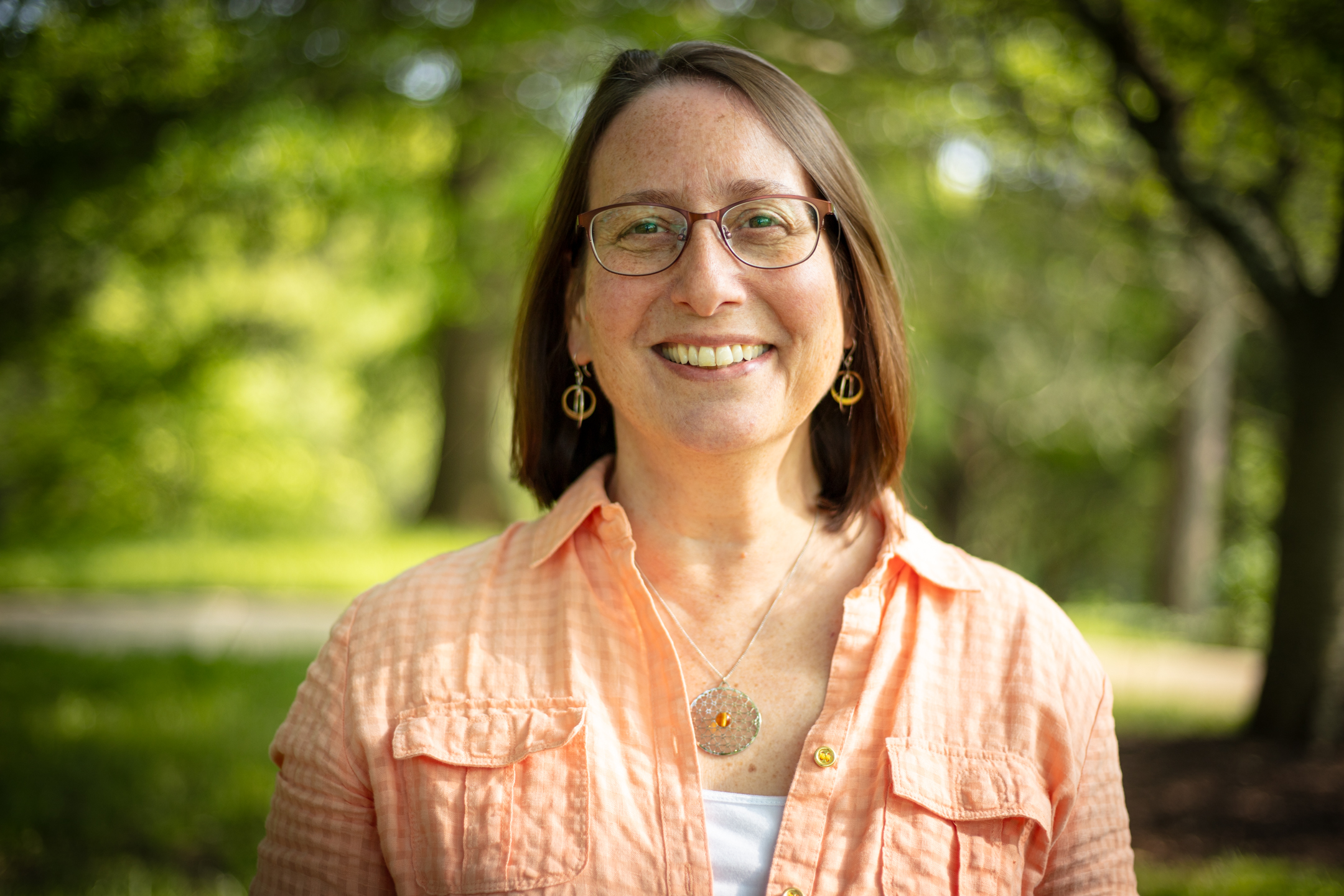
For the final questions, now that you’re in this new role, how should people at EPL get in touch?
People should just come talk to me!
Hopefully, people have always felt free to come talk to me, and they should continue to feel free. My door is open if I’m not on a Zoom call. I’m here every day that I’m not traveling for work or on vacation.
So stop by or drop me an email to talk about science or how to make Carnegie better.

